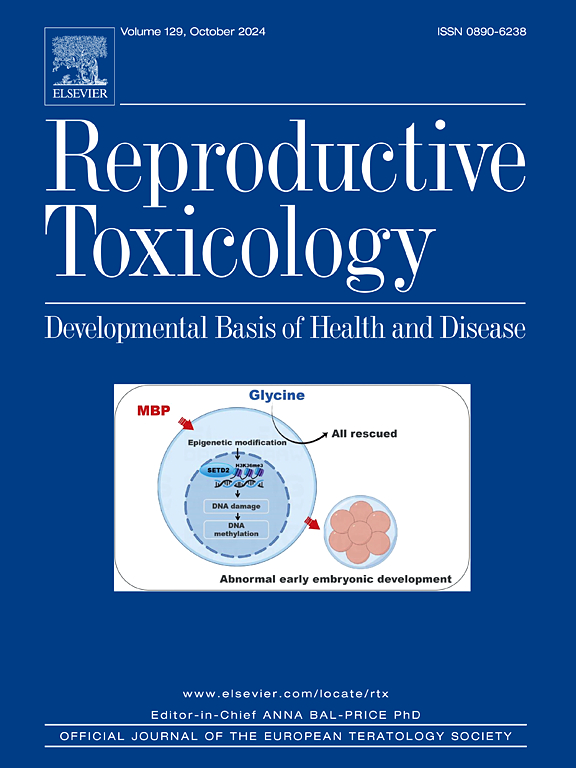1-(N-甲基-N-亚硝基氨基)-1-(3-吡啶基)-4-丁醛暴露会诱发雄性小鼠的睾丸毒性
IF 3.3
4区 医学
Q2 REPRODUCTIVE BIOLOGY
引用次数: 0
摘要
三手烟(Thirdhand smoke, THS)是指在主动吸烟结束后仍长期存在于室内环境中的一种残留的香烟烟雾,它引起了人们越来越多的健康关注。然而,三手烟暴露对男性生殖系统的影响,特别是在体内研究中,尚不清楚。因此,本研究旨在探讨三手烟中特殊成分1-(n -甲基-n -亚硝胺)-1-(3-吡啶基)-4-丁醛(NNA)对睾丸的不良影响。实验中,成年ICR小鼠分别口服稀释二甲亚砜(对照)、0.075 μg/kg和0.15 μg/kg NNA,持续10周。结果显示,NNA暴露,特别是0.15 μg/kg剂量下,显著降低睾丸上皮高度和小管面积。转录组学分析表明,NNA暴露干扰了与氧运输和氧结合过程相关的基因(如Hbb-bs)的表达,其下调也导致氧化损伤。此外,NNA暴露通过降低SOD和GSH酶水平以及增加MDA水平诱导睾丸氧化损伤。总之,我们的研究结果表明,NNA暴露会导致睾丸结构受损和氧化损伤,表明其睾丸毒性。这一发现不仅暗示了NNA对男性生殖的有害影响,也为进一步研究三手烟暴露对男性生殖健康的影响提供了基础依据。本文章由计算机程序翻译,如有差异,请以英文原文为准。
1-(N-methyl-N-nitrosamino)-1-(3-pyridinyl)-4-butanal exposure induces testicular toxicity in male mice
Thirdhand smoke (THS), a residual cigarette smoke still remaining in indoor environment long after active smoking has ceased, has aroused more and more people’s attention on health. However, the impact of THS exposure on the male reproductive system, particularly in in-vivo study, remain unclear. Thus, this study aims to investigate the adverse effects of 1-(N-methyl-N-nitrosamino)-1-(3-pyridinyl)-4-butanal (NNA), a special component in THS, on testis. Herein, adult ICR mice were orally administered diluted dimethylsulfoxide (control), 0.075 μg/kg and 0.15 μg/kg NNA for 10 weeks. The findings revealed that NNA exposure, especially in 0.15 μg/kg dosage, significantly reduced the epithelium height and tubular area within the testis. Transcriptomic analysis indicated that NNA exposure interfered with the expression of genes associated with oxygen transport and oxygen binding processes, such as Hbb-bs, the downregulation of which also led to oxidative damage. Additionally, NNA exposure induced oxidative damage in testis by decreased levels of SOD and GSH enzymes, along with an increase in MDA level. In summary, our results demonstrate that NNA exposure causes impaired testicular structure and oxidative damage, indicating its testicular toxicity. This finding not only implies the detrimental effect of NNA on male reproduction, but also provides a fundamental basis for further research on the impact of THS exposure on male reproductive health.
求助全文
通过发布文献求助,成功后即可免费获取论文全文。
去求助
来源期刊

Reproductive toxicology
生物-毒理学
CiteScore
6.50
自引率
3.00%
发文量
131
审稿时长
45 days
期刊介绍:
Drawing from a large number of disciplines, Reproductive Toxicology publishes timely, original research on the influence of chemical and physical agents on reproduction. Written by and for obstetricians, pediatricians, embryologists, teratologists, geneticists, toxicologists, andrologists, and others interested in detecting potential reproductive hazards, the journal is a forum for communication among researchers and practitioners. Articles focus on the application of in vitro, animal and clinical research to the practice of clinical medicine.
All aspects of reproduction are within the scope of Reproductive Toxicology, including the formation and maturation of male and female gametes, sexual function, the events surrounding the fusion of gametes and the development of the fertilized ovum, nourishment and transport of the conceptus within the genital tract, implantation, embryogenesis, intrauterine growth, placentation and placental function, parturition, lactation and neonatal survival. Adverse reproductive effects in males will be considered as significant as adverse effects occurring in females. To provide a balanced presentation of approaches, equal emphasis will be given to clinical and animal or in vitro work. Typical end points that will be studied by contributors include infertility, sexual dysfunction, spontaneous abortion, malformations, abnormal histogenesis, stillbirth, intrauterine growth retardation, prematurity, behavioral abnormalities, and perinatal mortality.
 求助内容:
求助内容: 应助结果提醒方式:
应助结果提醒方式:


